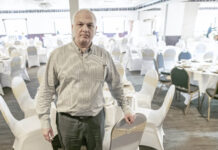There are a few local “firsts” in the history of dining out. The diner was invented in Providence in 1872. One of the most iconic diners, the Modern, was the first diner to be named to the National Register of Historic Places.
There is a local museum project that is uncovering more pioneering breakthroughs in food service in the state. The researchers have already uncovered at least one unexpected “first.”
Newport Eats is the name of the yearlong initiative being undertaken by the Newport Historical Society.
“Rhode Island is a gastronomic state,” noted society Executive Director Ruth Taylor, “and Newport has long been known as a center for fine dining and good food.”
Newport Eats features programs and exhibits that explore the role of food in Newport’s rich and diverse history.
“We will be looking at the lived experience of the past through food, and using that information to think about the future as well,” she explained.
As Taylor pointed out, everyone – from the privileged who built the iconic Gilded Age mansions to the working class who earned a living on a boat or in a factory – had food rituals.
Their daily lives and special occasions alike included food, as do ours today.
One of the inaugural initiatives of Newport Eats was to capture 21st-century food moments. The society began collecting and documenting current menus for restaurants and events to both add to its collection and to feature in an upcoming exhibit. A call for menus was put out to local restaurants, and a variety of Newport eateries, from those serving straight-up comfort foods, such as Ben’s Chili Dogs and Mamma Luisa’s, to choreographers of culinary experiences, such as hipster burger-mecca Mission and leading-edge seafood and creative cocktail landmark Fluke.
Other aspects of Newport Eats include exploring menus and recipes of the past. Here the going becomes slow, as businesses that served food down through time were not known as “restaurants” until the 1850s. Food was served to travelers at inns, taverns and cafes.
Locals ate out as well, but not always at an establishment that served food and drink. One of the earliest food-service businesses in Newport was a caterer who began as a storekeeper.
Newport’s bustling seaport brought foods from all over the world.
Well before the Gilded Age, in the years following the Civil War, restaurants opened all over town, many operated by African-Americans. The food was not fancy. When high society built its “cottages,” their sophisticated tastes were met by their own cooks who traveled with them. These cooks shared their recipes with the local shopkeepers and restaurateurs, who were quick studies in learning to prepare game such as peacock and French-style sauces.
By the 20th century, the occupants of the mansions were well-ensconced and a service industry had grown up to supply the society crowd with food and drink. Entertaining “at home” – a line item included on invitations to house parties that was code for an informal dinner party – became the norm. And here was where an unexpected discovery was made.
Mrs. Townsend Philips, a noted Newport socialite, had a dinner party in September 1964. Her menu, printed on invitation stock, included the origin of each course – turkey from Helger’s farm in Tiverton, salmon (served cold) from the Restigouche River, prime fly-fishing territory in New Brunswick, Canada, and hand melon, an heirloom variety of muskmelon prized by foodies to this day from Hand Melon Farm in upstate New York. This menu was nothing less than a very early example of “farm-to-table,” which is all the rage 50 years later.
Newport eats well, and always has. •
Bruce Newbury’s Dining Out talk radio show is heard on 920 WHJJ-AM, 1540 WADK-AM and on mobile applications. He can be reached by email at Bruce@brucenewbury.com.












